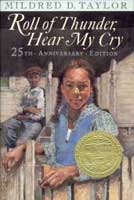
The books, cast-off by the white’s school as too damaged to use any longer, have been bestowed upon the black children and they are expected to be grateful. Little Man, the youngest of the Logan children and a very fastidious boy, rejects a book given out to him in class because it is shabby. The early chapters set all these conditions in place and the readers is aware of the underlying tensions in the community that might erupt at the slightest provocation.Īnd that provocation soon comes along. The unfairness is not lost on the children and sometimes they express their sense of injustice in ways that worry the adults, who know that for their own safety they must just keep their heads down and accept the reality. The children have the same worldview of any kids their age, but even at their young age they have a strong awareness of their low status compared to their white counterparts, for example, in the way most of the local white children treat them and how the white kid’s school seems so much better resourced (they even have a bus, while the Logan children have to walk several miles every day). The scene is set beautifully, mainly through the four children and in particular, Cassie’s narration. All the family contributes to the running of the farm and the income it generates. Despite owning 400 acres, the family still struggles to make ends meet, which is why Cassie’s father works away much of the year, on the railroad construction, and her mother works as a teacher at the local (black) school.

Grandfather Logan is now dead and the central character, Cassie, lives on the farm with her parents, her grandmother and three brothers. They are poor, but they own their own small piece of land, Grandfather Logan having bought it in the 1880s from local landowner Harlan Granger, much to the chagrin of some of the white locals who still cannot accept the social changes giving black people greater autonomy and rights. Roll of Thunder, Hear My Cry is the first of three novels by Mildred D Taylor about the Logan family, black farmers in Mississippi, set in the 1930s.



My edition is published by Puffin and the narrator and main character is a child, but make, no mistake, the themes here are mature and heavyweight. However, it is a classic and, in my view, essential teenage reading. First published in 1976, this rather pre-dates the emergence of the YA genre, so it does not fit quite so comfortably. I chose this book as February’s choice for my Facebook Reading Challenge 2019.


 0 kommentar(er)
0 kommentar(er)
